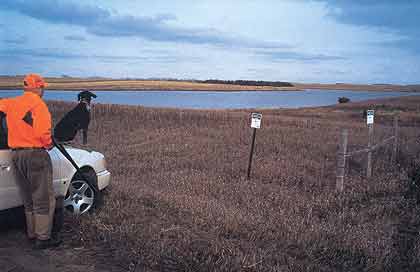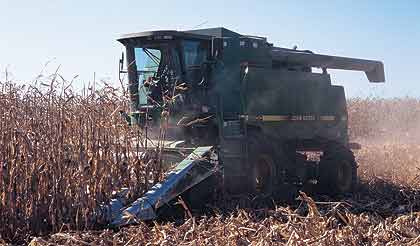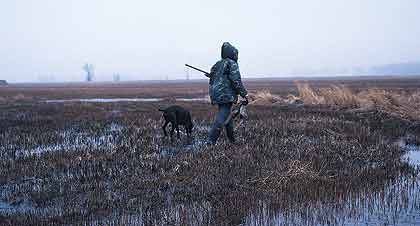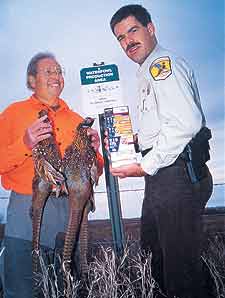Tips for hunting pheasants according to the clock and the calendar
By Jerry Thoms
"Shoot!" Though not the exact word my hunting partner used, it was close to the one he did say in expressing his dismay when we arrived at a 200-acre plot of public hunting property. Hoping to find a wide-open place to hunt pheasants, what we saw instead were seven other hunters with three dogs trooping through the tall grass field we had thought would be ours alone.
"Don't worry," I told my friend, "those guys are way too early. Their timing is off by more than an hour. There won't be many pheasants in this field until 30 minutes before sunset. We'll be back here then to roust up some roosters that come here to bed own for the night."
An hour and a half later, after walking this public property for 30 minutes right up to sundown, we were headed to my truck, each of us with a ringneck in our game bags. My hunting partner was treating me like some kind of pheasant hunting guru with magical powers. But there wasn't anything supernatural in what we had done. Rather, our success was the result of some simple observations of the obvious "timing" factors that influence the pheasants on this public land.
In my home state of South Dakota as well as in North Dakota, Minnesota, Iowa, Nebraska and many other states, there are millions of acres of prime tracts of public land known as Waterfowl Production Areas, Game Production Areas, Walk-In-Acres, National Grasslands, and Corp of Engineers Property. These tracts of open-for-free-to-public-hunting land may typically have sloughs, ponds, streams, rivers, and lakes surrounded by upland habitat covered with tall grass, cattails, trees, and other top quality, wildlife-friendly vegetation. Purchased with funds from hunting license fees and managed by various government agencies, these wetlands/uplands are officially dedicated as habitat for wildlife of all species. They are, in most cases, perfect places for ringneck pheasants.
These are permanent tracts of property open for hunting free to the general public, are usually identified in state and federal guides to public hunting land, and are often some of the best pheasant habitat in many parts of each state. Consequently, these are popular spots receiving a great deal of shooting pressure from local and non-resident hunters. For example, one landowner, who lives across the road from a 360-acre Waterfowl Production Area a dozen miles from my hometown in east-central South Dakota, says that on opening day of the pheasant season as many as six groups of hunters will go through this tract of land.
With an average of six hunters and two dogs per group, it doesn't take long for 25 to 35 hunters to kill or kick out many of the roosters on the place.
 There are times during the day when waiting and watching for pheasants to fly into public land is a better strategy than randomly charging into the cover. Spend time watching, mark any distant roosters, then go after them. |
How can these public places be any good for hunting with all these people and all this shooting pressure? This is a good question to which there are some good answers, all of which center on the matter of "timing"€¦i.e., when to hunt these prime tracts of public property. Here are those answers.
1. Hunt early and hunt late when looking for roosters on public property. The beginning of the season, from the opening day through the second weekend, is when 75 percent of the pheasant hunters will be in the field. After that 10-day period, the majority of them will stay home because they have other things to do.
During this time, the popular assumption might be that public land would be a good place to avoid because of the high volume traffic through these popular pieces of real estate. But this isn't necessarily the case because roosters will still use this habitat--though not all day.
 Whenever possible, time trips to public land to coincide with the harvest of nearby crop fields. |
Instead, the birds will leave early and come back late, using the area as a regular all-night roosting site. Consequently, the first hunters there in the morning right at sun-up and the last ones there a half hour or so before sundown will have a good chance at a bird or two€¦ even within the busy first 10 days of the season.
Don't expect to shoot a three-bird limit during this time period, but do expect a good chance at a rooster or two. If you have a dog with some talent for trailing running ringnecks or you have the patience and skill to stalk and spook pheasants into flushing, so much the better. Remember, even early in the season these pheasants are highly stressed by hunting pressure, get smart in a hurry, and can be as difficult to bag as veteran birds can be way at the end of the season.
2. Use a narrow time frame to hunt the most promising exit and entrance locations for pheasants on public land. Consider the time of the day when sizing up the landscape and figuring out the most likely direction pheasants will leave or return to the habitat.
In hunting the Waterfowl Production Area referred to in the beginning of this article, my partner and I concentrated on the part of the grass cover closest to an adjacent field of standing corn. In the corn, we reasoned, the birds had spent most of the day feeding, loafing, and staying out of harm's way. In the last half hour before sunset, they would walk or fly back into their grass-covered bedroom for the night. That's when we gave two roosters a goodnight kiss with our 12 gauges.
Whether hunting in the early morning or late afternoon, the same close correlation between roosting cover and crop lands would be a logical factor in deciding which part of the WPA to walk for the most likely contact with roosters headed into the corn for breakfast or returning to the WPA for the night.
 Wet, foggy, cold or snowy weather may cause pheasants to hold tighter than usual on public land, and competition from other hunters is also likely to be reduced. |
3. Pick the middle of the week as the best time to hunt public land. As with any hunting property, weekends on public land will be most popular with most pheasant hunters. Consequently, if possible, plan your trips to these places during the week. Tuesdays, Wednesdays and Thursdays are best because generally fewer people are out on those days. My landowner friend who lives across from a WPA in South Dakota says that hunter use of this public land clearly declines during the week and definitely increases on weekends.
Avoid Mondays so the birds have one day to settle back into their old routines and stay away on Fridays because more hunters now days start their weekends on this day. Pheasants are creatures of habit and most of the time, even if their movement patterns are temporarily disturbed, they will return to their regular routine and normal behavior within a few days.
 Non-toxic shot is required to hunt on almost public land, and the regulations are strictly enforced. |
4. Time your trips to public hunting spots according to the worst weather conditions. Most all of this land offers all wildlife some of the best protective habitat in the country when the weather is wet, foggy, windy, cold, icy, snowy, or otherwise inclement. So go to these public places because this is where the pheasants will be to get out of any bitter weather conditions. Generally, the worse the weather, the longer it has been nasty, and the closer it correlates to other key timing factors mentioned here, the better the hunting will be on public lands.
Cloud cover is one weather condition we may not regard as extreme, but the light conditions clouds create can have an enormous impact on pheasant behavior. Heavy cloud cover ranging from dense fog to low thick overcast will often cause roosting pheasants to linger longer in roosting cover in the morning. Likewise, heavy cloud cover that can produce low light throughout the day may fool pheasants into returning to roosting sites long before sundown--sometimes a couple of hours before the last hour of the day.
When this happens, be there.
5. Time a hunt on public land to coincide with crop harvest in nearby fields. When pheasants leave in the morning, they usually head for feeding fields. Unharvested corn, sorghum, milo, sunflowers, even weedy haylands will provide pheasants food and cover all day long. But one day the combine will come along and in a few hours the jungle of habitat that provided easy food and all-day protection is suddenly gone. You can easily guess where these birds will go then.
Because most corn, soybeans, sorghum, sunflowers and cane forage are often harvested later in the fall, sometimes several weeks into the hunting season, this big change in the landscape many times goes unnoticed by pheasant hunters. In many instances, public hunting spots that everyone thought were burned out by over-hunting are suddenly pheasant Meccas. Even public lands close to high population metropolitan centers might again become rooster hotspots for those who pay attention to the sudden changes that harvest time can bring.
6. Time your public land pheasant hunting for the shorter days of the late season. Toward the end of the pheasant season, daylight hours are much shorter, the temperatures are much colder, the skies can be much grayer, and snow is often on the ground--all timing factors that will have a direct influence on pheasant behavior.
During this time and under these conditions, the birds will often spend less time feeding because the crop fields are now stubble fields with little protection from the elements or from predators. Also, the public places will often be the best cover in the region, sometimes holding pheasants in flocks of dozens. Walk these areas at the right time and these public lands can provide some golden opportunities for bagging trophy roosters.
Conclusion
In the upper Midwestern states of South Dakota, North Dakota, Minnesota, and Nebraska, there are millions of acres of public land, all of it home to multitudes of huntable pheasants--and all with free access to the general public. The average uninformed hunter, however, may walk these huge tracts of rooster habitat at the wrong time and go away convinced there are few or maybe no birds there. But apply these timing tips the next time you visit one of these places. You may be just in time for a big surprise.






